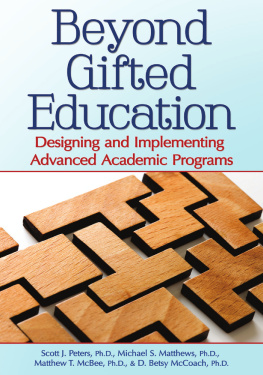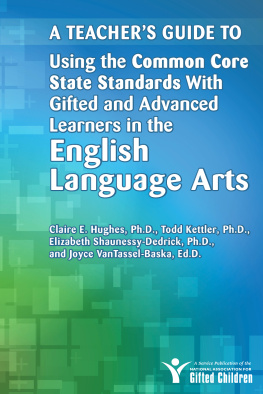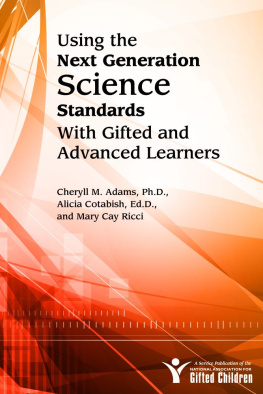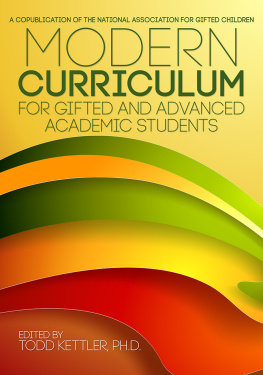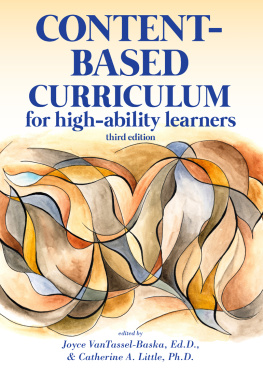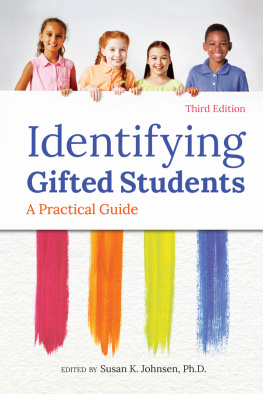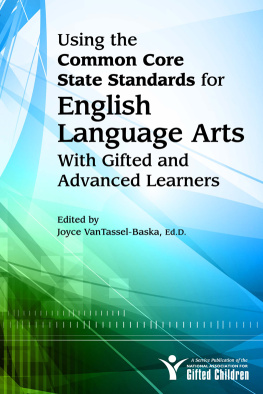Copyright 2015 National Association for Gifted Children
Edited by Rachel Taliaferro
Production design by Raquel Trevino
ISBN-13: 978-1-61821-285-6
No part of this book may be reproduced, translated, stored in a retrieval system, or transmitted, in any form or by any means, electronic, mechanical, photocopying, microfilming, recording, or otherwise, without written permission from the publisher.
At the time of this books publication, all facts and figures cited are the most current available. All telephone numbers, addresses, and website URLs are accurate and active. All publications, organizations, websites, and other resources exist as described in the book, and all have been verified. The authors and Prufrock Press Inc. make no warranty or guarantee concerning the information and materials given out by organizations or content found at websites, and we are not responsible for any changes that occur after this books publication. If you find an error, please contact Prufrock Press Inc.

Prufrock Press Inc.
P.O. Box 8813
Waco, TX 76714-8813
Phone: (800) 998-2208
Fax: (800) 240-0333
http://www.prufrock.com
Acknowledgments
Many people have assisted with the efforts in developing this book. They include the leadership of the National Association for Gifted Children (NAGC), the NAGC Professional Standards Committee, reviewers, NAGC staff, and experts who were a part of the development of the other books in this series on using the Common Core State Standards (CCSS) with gifted and advanced learners.
We would like to thank Tracy L. Cross, NAGC president; past president Paula OlszewskiKubilius; and the NAGC Board, who have understood the urgency for responding to the national standards movement, including the Next Generation Science Standards (NGSS) and the Common Core State Standards, and the gifted education communitys need to have a voice in their implementation. From the beginning, the NAGC Professional Standards Committee also has been actively involved in providing the framework, expertise, and support for this book. Moreover, the NAGC leadership group also includes Executive Director Nancy Green and Association Editor Carolyn Callahan, who have both supported the development process and the need for this book.
This book has also been strengthened through a rigorous review process. We want to thank the reviewers Steve Coxon, Jeff Danielian, and Chrys Mursky, who took time to provide valuable advice and feedback.
Finally, the authors want to express a special thank you to Jane Clarenbach, Director of Public Education at the NAGC office, who has provided the needed energy in supporting the authors through the process and a critical eye in editing the many drafts of this book.
Foreword
A Teachers Guide to Using the Next Generation Science Standards With Gifted and Advanced Learners is the second publication from the National Association for Gifted Children (NAGC) on differentiating the Next Generation Science Standards (NGSS). Although the NGSS to date have not been as widely adopted as the Common Core State Standards (CCSS), they provide the opportunity to bring gifted education strategies to all students, not only to those who have been identified as gifted. Talent development based on these strategies begins early, and users of this book will find examples of challenging learning experiences as early as kindergarten. In an effort to facilitate advanced learning as it relates to these important standards, NAGCs goal is to help teachers encourage early scientific thinking as a way to identify science talent. In addition, it has much to offer that will help teachers to develop confidence to modify and extend the standards for students ready to move at a faster pace or who are interested in an in-depth examination of a core idea within the standards.
To be effective with NGSS, early education teachers will need more knowledge of science content and secondary teachers will need additional pedagogical skills than either might have received in their teacher preparation programs. Thus, professional development opportunities will be essential in successfully implementing the standards with all students. The authors, who are well qualified in gifted education strategies, describe the elements of professional development that will ensure teachers are able to make the needed changes in their classrooms to challenge and support advanced learners.
There is much to celebrate with increased emphasis on rigorous standards, but we must be careful not to think that gifted and advanced learners will be appropriately challenged without additional work on the part of schools. I am confident that this book will be a useful resource for all educators, not just those working specifically in gifted education programs.
As is often the case, NAGC is indebted to a group of experts who volunteered their time and expertise to ensure that members and others who work with advanced and gifted students in science have outstanding resources that support teaching and learning related to these important new standards. We thank Cheryll Adams, Alicia Cotabish, and Debbie Dailey for their contributions to this project.
Tracy L. Cross, Ph.D.
President, NAGC
Chapter 1
Overview
The purpose of this book is to provide classroom teachers and school administrators examples and strategies to implement the new Next Generation Science Standards (NGSS) for advanced learners at all stages of development. One aspect of fulfilling that purpose is to clarify what advanced opportunities look like for such learners as they progress from kindergarten through high school. How can teachers provide the level of rigor and relevance within the new standards as they translate them into experiences for gifted learners? How can they provide creative and innovative opportunities that will nurture the thinking and problem solving of our best students?
This book also serves as a primer for guiding policies and practices related to advanced learners in school. At all levels, schools must be flexible in the implementation of policies related to acceleration, waivers, and course credit, all of which may impact gifted learners. The developers of the NGSS acknowledge that advanced learners may move through the standards more readily than other learners (Achieve, Inc., 2014a), attesting to the importance of using differentiated approaches for these learners to attain mastery and/or progress in academic achievement at their level. It is critical that schools allow for flexibility in these areas and others in order to accommodate the special needs of our advanced learners.
This book is based on a set of underlying assumptions about the constructs of giftedness and talent development that underpin the thinking that spawned Using the Next Generation Science Standards With Gifted and Advanced Learners (Adams, Cotabish, & Ricci, 2014). These assumptions are:
Giftedness is developed over time through the interaction of innate abilities with nurturing environmental conditions. Thus the process is developmental, dynamic, and malleable.
Many learners show preferences for particular subject matter early and continue to select learning opportunities that match their predispositions if they are provided with opportunities to do so. For many children, especially those in poverty, schools are the primary source for relevant opportunities to develop domain-specific potential, although markers of talent development also emerge from work done outside of school in cocurricular or extracurricular contexts.



